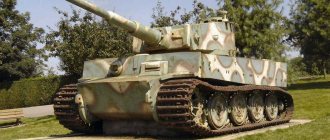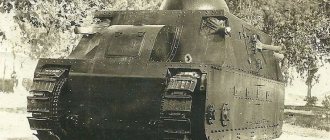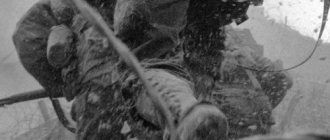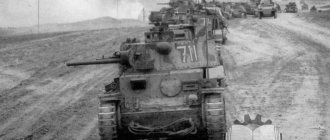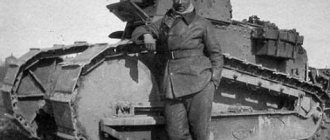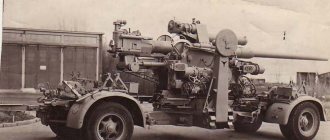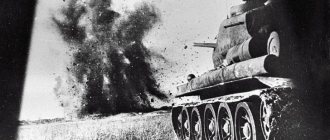Japanese tank building dates back to the 20s of the last century. Until the creation of a modern tank, several lines can be clearly traced in the design of combat vehicles.
Firstly, due to a constant shortage of raw materials, tanks were never built in large numbers. The maximum was reached in 1942, then 1191 units were built per year, then the number constantly decreased. For comparison, over 24,000 tanks were produced in the USSR during this period, and 6,200 in Germany.
Secondly, to ensure dominance over the Pacific theater of operations, Japan gave priority to the construction of a powerful fleet and aviation, and the ground forces were assigned the role of “cleaning up.”
Even the decree “Program of Emergency Measures to Achieve Victory,” adopted on January 25, 1945, gave priority to the construction of aircraft in the production of weapons. Therefore, for the successful transfer of tanks by ships, the latter had to be light in weight and dimensions. Due to both reasons, Japanese industry never produced heavy combat vehicles.
Japanese strategists believed that there could be no tank battles on the islands, so for a long time tanks were armed only with machine guns to destroy manpower and suppress enemy firing points. By the way, the strategists turned out to be right - tank battles on the islands were extremely rare.
Use of tanks by the Japanese Army
The regulations and instructions of the Japanese Army assigned tanks the role of short-range reconnaissance and infantry support in battle and, therefore, large tank units were not created until 1941.
The main task of tanks, as stated in the 1935 regulations, is “to fight in close cooperation with the infantry.” That is, as already mentioned, the destruction of enemy personnel, the fight against his firing points, the suppression of field artillery that was not suppressed during air and artillery preparation, as well as a breakthrough in the defensive line of defense passages for infantry.
Limited interaction between tanks and aviation and field artillery was allowed. Sometimes tank units or just one tank were sent beyond the enemy’s front line of defense to a maximum depth of 600 m, in so-called “close raids.” After a breach of the defense system, the tanks had to immediately return to the infantry to support their attack.
As a kind of reconnaissance, small tanks were used in the first echelon, which revealed the enemy’s fire system, followed by medium and light tanks with infantry. Objectively, this system of combat became outdated after the First World War, but in conflicts in Burma, China, Malaya and other countries it brought certain results. Sometimes tanks were used as part of joint groups for deep raids; in addition to tank units, the group included motorized infantry, cavalry and sappers in field artillery vehicles. During the march, tanks with the task of destroying the enemy interfering with the advance could be assigned to the vanguard. At the same time, they had to move either “leaps” ahead of the vanguard or on a parallel course. During outpost security, 1-2 tanks could be allocated to the post.
During defense, they were used to carry out counterattacks or fire from ambushes, and were often used as fixed firing points. Direct battles with enemy tanks were strictly prohibited and allowed only as a last resort.
The personnel of the tank forces as a whole were quite well trained. Drivers, radio operators, artillerymen, and gunners were trained in special schools for 2 years. Tank commanders were recruited from among the combined arms, who would not part with their sword even inside the tank. To comply, they only underwent retraining for 3-6 months.
In general, the characteristics of the military operations of the Japanese army showed notes characteristic of the military concepts of the USSR and Germany - maneuverability and surprise, but the small number and low technical characteristics of tanks forced them to be considered more like positional weapons.
CONTENT
- 1 Initial purchase of tanks
- 2 Doctrine
- 3 Japanese designs 3.1 Type 87 Chi-I (Tank No. 1)
- 3.2 Type 89 Chi-Ro medium tank
- 3.3 Type 95 Ha-Go light tank
- 3.4 Type 97 Chi-Ha medium tank
- 3.5 Type 98 Ke-Ni light tank
- 3.6 Type 1 Chi-He medium tank
- 3.7 Type 3 Chi-Nu medium tank
- 3.8 Type 4 Chi-To medium tank
- 3.9 Type 5 Chi-Ri medium tank
- 3.10 Experimental tank destroyer Type 5 Ho-Ri
- 3.11 OI super heavy tank
- 3.12 Amphibious tanks
- 3.13 General production
- 5.1 Notes
Designation of Japanese tanks
To designate military equipment and weapons in Japan, two interchangeable options were used: numerically or using hieroglyphs.
When designating numerically, the year the model was adopted into service was used according to the chronology “from the foundation of the Empire” (660 BC). Before the “round” year of 1940 (3000 according to the Japanese calendar), the full designation (four digits) or the last two were used, so the 1935 model was called “type 2595”, “2595” or “95”, and for the 1940 model - “type 100". Starting from 1941, only the last digit was used in the designation: model 1942. - “type 2”, 1943 - “type-3”, etc.
Another designation option used names consisting of a hieroglyph indicating the type of combat vehicle and a counting hieroglyph.
For example, "Ke-Ri" and "Ke-Ho". Here the numerical value corresponded to the development number, and not the year of adoption. It goes without saying that there were exceptions, for example, “Ka-Mi” consists of the word “floating” and the beginning of the name of the company “Mitsubishi”, and “Ha-Go” is made up of the “counting” hieroglyph and the word “model”. Sometimes some cars were named after the name, "Sumida". Some documents, including Japanese ones, use Latin abbreviations to designate tanks and armored vehicles, as in prototypes.
If we talk about Japanese tanks in general, they were distinguished by their low weight and weak armor. With a specific pressure of 0.7-0.8 kg/cm2, they had good maneuverability. But at the same time they had weak fire support, primitive means of observation and were provided with poor communication devices.
Until 1940, when welding was used, tanks were assembled using rivets on the frame. Taking into account the short stature of the tankers, the internal space was compressed to the maximum. Repair and maintenance of components and assemblies was facilitated by the abundance of hatches, which at the same time weakened the armor plates.
Among the positive characteristics, it can be noted that the Japanese were the first in the world to use forward machine guns and diesel engines; different classes of vehicles used the same commander's cupolas, the same suspension design, etc., which greatly facilitated the training of personnel.
O-Ho – (VIII level) – nimble monster
O-Ho is the first representative of super heavy Japanese tanks, which has an interesting feature: it has the highest turning characteristics. That is, the degree of rotation of this tank is much higher than that of others, so it already automatically gets rid of some inconveniences. True, in terms of speed, this tank again disappoints with its performance, since the speed does not exceed 25 km/h. Although, if you act correctly, you can use them for the benefit of the battle.
The last interesting feature is the terribly strong turret, which has 200mm of all-round armor. This is a pretty good achievement for level 8, which can contribute to good results.
True, if you look at the tank hull itself, you may again be disappointed by the sides, which have weak armor of 105 mm and many weak points. Why the sides are a weak point, it is worth remembering about an artillery shell, which in most cases will explode near you and demolish your sides along with the crew and modules.
History of Japanese tank building
Japan's first own tank was the experimental double-turret tank "Chi-i" (medium first) weighing 18 tons, built in 1927 by the Osaka arsenal. Before this, foreign-made tanks were used, the French M21 Chenillet, Renault FT-18, NC-27, Renault NC-26, English Mk.IV, Mk.A Whippet, MkC, Vickers, Vickers were purchased 6-ton." All purchased samples were carefully analyzed by the designers. So in the French ones (they went into production as “Otsu”) the engine was replaced with a diesel one. By the way, the French NC-27 (“Otsu”) and Renault FT-18 (“Ko-gata”) were used by the army until 1940.
In addition to the two-turret "Chi-i", the 18-ton three-turret tank "Type 2591" and in 1934 the three-turret "Type 2595" were created in 1931. If these vehicles were at least actually created, then the creation of the “Type 100” or “O-i” (the large first) stopped at design work; the three-turret vehicle weighing 100 tons was planned to be used to break through fortified areas. At this point, experiments with the creation of multi-turret tanks ended, several built "2591" tanks were used in China.
Based on the Vickers Mk.S tanks in the early 30s. The medium tank “I-go” (“first model”) or “89 Ko” was created. It became the first production tank; 230 were produced from 1931-1937.
Japanese tank building received a significant boost after the Supreme Command made a decision on large-scale mechanization of the army in 1932, which was followed by corresponding orders from industry.
The Japanese managed to avoid the craze for wedges. After analyzing the purchased Carden-Loyd wedge, the Japanese created the Type 2592 small tank. It used the suspension proposed by the most famous Japanese tank designer, Tomio Hara. The model turned out to be so successful that several new models were subsequently built on it.
In 1935, the industry began producing the most famous light tanks, the Ha-Go, and from 1937, the medium tanks, the Chi-Ha. Both models were the main ones in the Japanese tank fleet until the end of World War II.
Planning military operations on the islands required the presence of floating combat vehicles for landing. Work on the creation of such machines has been carried out with varying degrees of success since the late 20s, but the peak came at the end of World War II. In 1934, there was an attempt to create an amphibious tank by giving the body a displacement shape “2592” or “A-I-Go”, from 1941. the floating “Type 2” or “Ka-mi” was introduced commercially, from 1943 “Type 2” or “Ka-chi”, and in 1945. "Type 5" or "To-Ku" appeared.
After the transition to strategic defense, tank production increased significantly, some models underwent modernization, some were discontinued and replaced with new models. This is how the lungs appeared: 1943 - modernized "Ha-go" - "Ke-ri" (light sixth), 1944 - "Ke-nu" (light tenth), 1944 - "Ke-Ho" (light fifth); and middle ones: 1941 modification of “Chi-ha” - “Chi-He” (middle sixth), 1944 - “Chi-to” (middle seventh), 1945 - in a single copy “Chi-Ri” (middle ninth), 1945 - "Chi-Nu" (middle tenth).
Links[edit]
Notes[edit]
- Zaloga 2007, p. 4.
- Jump up
↑ Hara 1972, p. 3. - ^ ab Tomczyk 2002, pp. 7, 10.
- Zaloga 2007, pp. 4, 5.
- Jump up
↑ Foss 2003, p. 220. - Zaloga 2007, pp. 3, 13, 15.
- Zaloga 2007, pp. 15-18.
- ^ ab Tomczyk 2005, pp. 3, 5, 29.
- Zaloga 2007, pp. 3, 22.
- Tomczyk 2002, pp. 3, 4.
- Jump up
↑ Hara 1972, pp. 3, 4. - ^ ab Imperial Japanese Army Taki: "The Development of Japanese Imperial Tanks"
- Jump up
↑ Hara 1972, pp. 1–4. - Jump up
↑ Hara 1972, p. 1. - Jump up
↑ Hara 1972, p. 4. - Tomczyk 2002, p. 7.
- Jump up
↑ Hara 1972, p. 5. - Jump up
↑ Hara 1972, pp. 15–17. - Tomczyk 2002, pp. 7, 10, 17.
- Tomczyk 2002, pp. 19, 25.
- ^ a b Zaloga 2007, pp. 5, 6.
- Tomczyk 2002, p. 17.
- Zaloga 2007, p. 5.
- ^ a b Zaloga 2007, p. 10.
- Tomczyk 2002, p. 27.
- ^ a b Zaloga 2007, p. 11.
- Zaloga 2007, pp. 10, 17.
- Tomczyk 2002, pp. 67, 74.
- Zaloga 2007, page diagram D.
- COOX 1985, pp. 350, 370.
- ^ ab Hunnicutt 1992, p. 395.
- Zaloga 2007, pp. 16, 17 photo and signature.
- Zaloga 2007, pp. 18, 19, 20.
- Tomczyk 2007a, p. 19.
- Zaloga 2007, pp. 10, 11, 13, 14.
- Zaloga 2007, p. 14.
- Zaloga 2007, p. 16.
- Tomczyk 2005, p. 61.
- Zaloga 2012, p. 15.
- ^ ab War History: Type 98 Chi-Ni Light Tank
- ^ abc Pledge 2007, p. 18.
- ^ abc Pledge 2007, p. 17.
- Tomczyk 2007b, p. 14.
- Zaloga 2007, pp. 17, 18.
- ↑
War Story: Type 98 Type 2 Ke-To Light Tank - Tomczyk 2007a, p. 20.
- ^ a b Zaloga 2007, p. 20.
- ↑ ab Zaloga 2007, p. 21, 22.
- Zaloga 2007, pp. 17, 23.
- Imperial Japanese Army Taki in: "Tanks after Chi-Ha"
- Tomczyk 2005, p. 3.
- Zaloga 2007, pp. 17, 21.
- Tomczyk 2005, pp. 3, 32.
- Tomczyk 2005, pp. 3, 5.
- ^ ab War History: Type 4 Chi-To Medium Tank, retrieved December 10, 2014.
- ^ abcde Pledge 2007, page 22.
- Tomczyk 2005, pp. 19, 20.
- Jump up
↑ Hara 1972, p. 18. - Tomczyk 2005, pp. 19, 20-22, 30.
- Jump up
↑ Miller 2000, p. 187. - ^ ab War History: Type 5 Chi-Ri Medium Tank, retrieved 10 December 2014
- Tomczyk 2005, pp. 29, 30.
- Tomczyk 2005, p. 29.
- ^ ab Tomczyk 2005, p. 23.
- Tomczyk 2007b, pp. 10, 30.
- Tomczyk 2007b, p. 31.
- Tomczyk 2007b, p. 33.
- Tomczyk 2007b, p. 10.
- Imperial Japanese Army Taki's: 105mm SP Gun Tank "Ho-Ri"
- ^ ab Estes 2014, p. 37.
- ^ abcd Imperial Japanese Army Taki: "OI" super heavy tank
- Jump up
↑ Estes 2014, pp. 37, 38. - Tomczyk 2003, pp. 3, 4, 32.
- ^ ab Tomczyk 2003, p. 4.
- ^ a b Pledge 2007, pp. 23, 24.
- "Imperial Japanese Army Taki: Type 2″ Ka-Mi landing vehicle". Archived from the original on 2012-02-28. Retrieved September 27, 2016.
- Tomczyk 2003, pp. 29, 30.
- Zaloga 2007, p. 24.
- Imperial Japanese Army Taki's: Type 3 amphibious tank "Ka-Chi"
- Tomczyk 2003, pp. 32, 33, 43.
- Tomczyk 2007b, p. 141.
- Zaloga 2007, p. 3; "Japan was at the forefront of tank technology in the 1930s."
- Zaloga 2007, pp. 17, 19-24.
Bibliography[edit]
- Cooks, Alvin D. (1985). Nomonhan: Japan vs. Russia, 1939
. Two volumes. Stanford University Press. ISBN 978-0-8047-1160-9. - Estes, Kenneth (2014). Super-heavy tanks of World War II
. Osprey. ISBN 978-1782003830. - Foss, Christopher (2003). Tanks: 500. Crestline. ISBN 0-7603-1500-0.
- Hara, Tomio (1972). Japanese medium tanks
. AFV weapon profiles No. 49. Limited profile publications. - Hunnicutt, R.P. (1992). Stewart: The Story of the American Light Tank
. Volume one. Presidio Press. ISBN 978-0-89141-462-9. |volume=there is additional text (help) - Miller, David (2000). Illustrated reference book of tanks of the world
. Zenith Imprint. ISBN 978-0-7603-0892-9. - Tomczyk, Andrzej (2002). Japanese Armor Vol.
1 . AJ Press. ISBN 83-7237-097-4. - Tomczyk, Andrzej (2007a) [2002]. Japanese Armor Vol.
2 . AJ Press. ISBN 978-8372371119. - Tomczyk, Andrzej (2003). Japanese Armor Vol.
3 . AJ Press. ISBN 978-8372371287. - Tomczyk, Andrzej (2005). Japanese Armor Vol.
4 . AJ Press. ISBN 978-8372371676. - Tomczyk, Andrzej (2007b). Japanese Armor Vol.
5 . AJ Press. ISBN 978-8372371799. - Zaloga, Stephen J. (2007). Japanese tanks 1939–45
. Osprey Publishing. ISBN 978-1-8460-3091-8. - Zaloga, Stephen J. (2012). M4 Sherman vs Type 97 Chi-Ha: The Pacific 1945
. Osprey Publishing. ISBN 978-1849086387.
Modern Japanese tanks
After the end of World War II, under American occupation forces, the production of armored vehicles in Japan completely ceased. Its restoration began with the creation of the “self-defense forces,” which at first were armed with the American M24 and M4. It should be noted that all post-war tank building in Japan is under the strong influence of the United States. Mitsubishi Heavy Industries became the main developer of tanks.
The first post-war tank was the Type 61, which remained in service until 1984. The tank featured pre-war traditions, such as a rear-mounted engine with front-wheel drive. Starting in 1962, development began on the main battle tank, which became the serial “74”. First of all, to counter the Soviet T-72, the third generation tank 90 was adopted into service in 1989. On February 13, 2008, Japan introduced the latest generation tank, the Type 10. In appearance, the Type 10 resembles the Merkava Mk-4 and Leopard 2A6, but in terms of dimensions and weight it is closer to Russian tanks. In principle, this is only a prototype and it may go into production with some changes.
More material on the topic
- M4 Sherman
- New deadly tank T90MS
Type 95 (tier IV) - new “turtle”
Type 95 is the very first representative of the Japanese branch of heavy tanks. It immediately amazes with its size, but does not at all inspire positivity in its technical characteristics.
It has a powerful weapon and an interesting rate of fire, however, it is not at all pleasing with its armor, which in the thickest places reaches only 50 mm. In addition, you should not expect positive aspects in its maneuverability, which, combined with its low speed, will not particularly allow you to turn around on the battlefield and will force you to act according to one scenario and only one choice.
